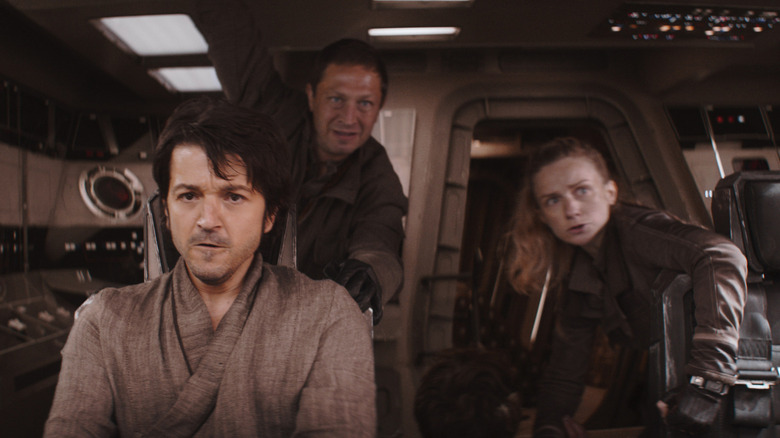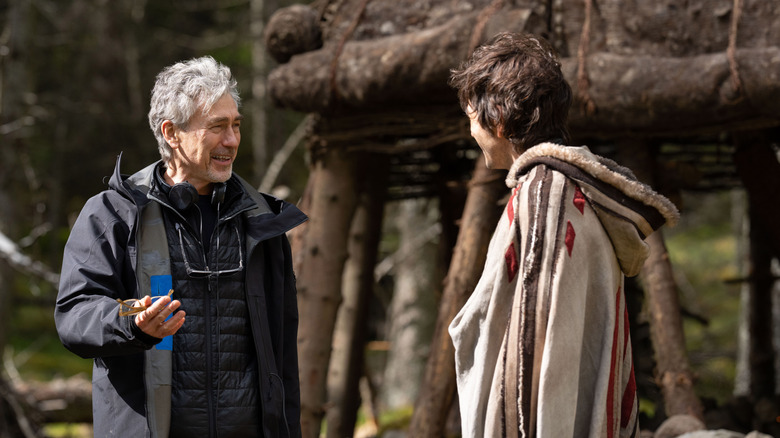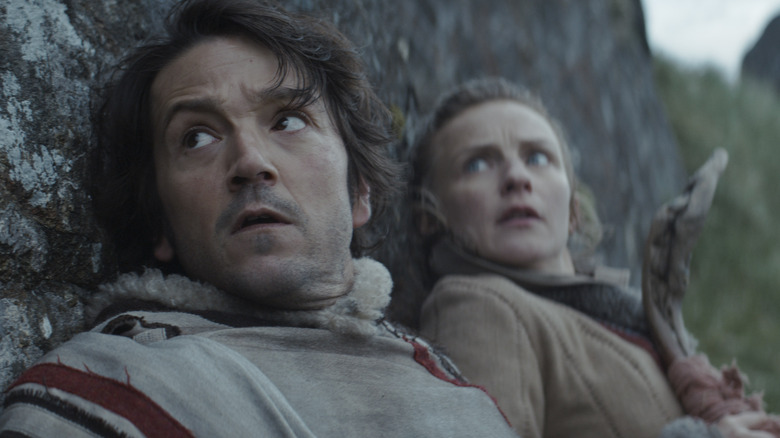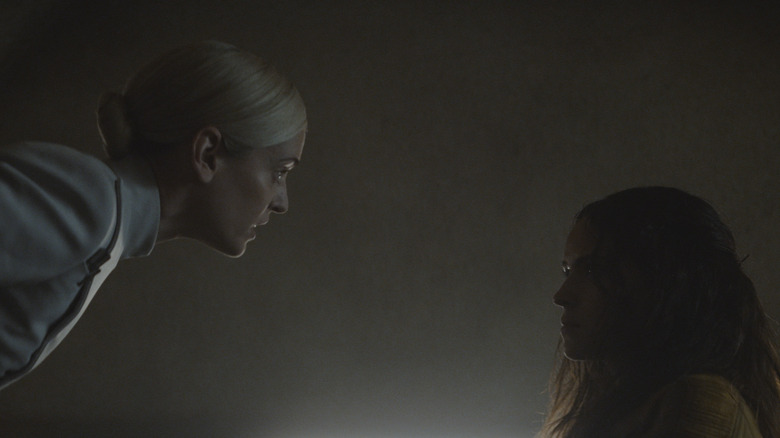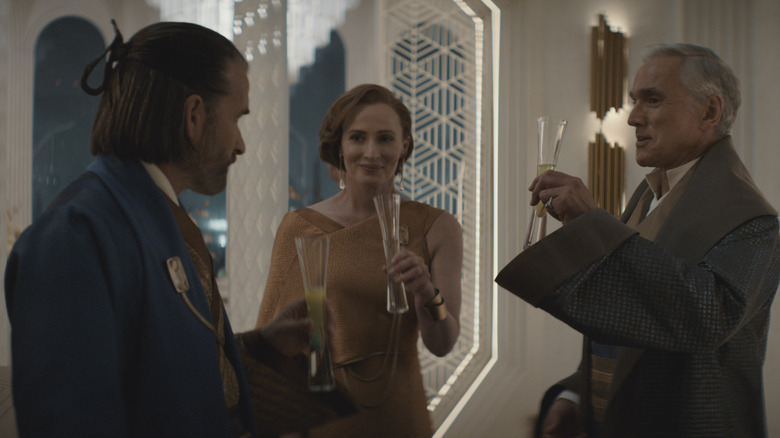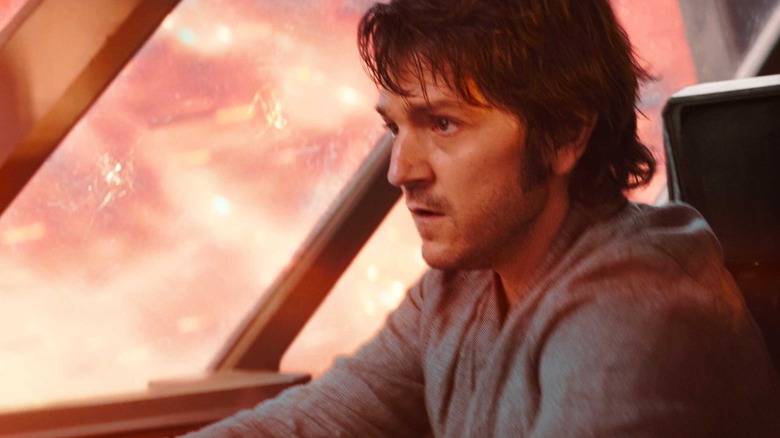Andor VFX Producer And Supervising Sound Editor Tell Us About Creating The Eye Of Aldhani And More [Exclusive Interview]
It's easy to watch a series as acclaimed and well-received as "Andor" and heap credit upon the most obvious, surface-level aspects that immediately leap out at most audiences. In terms of a breath of fresh air, the final result feels like the most original and ground-breaking "Star Wars" production we've received since Disney first took ownership of Lucasfilm. What more needs to be said about how creator Tony Gilroy managed to capture lightning in a bottle and deliver something most fans have never seen from this franchise?
Well, there's plenty left to say, and that's where the recent below-the-line press day for "Andor" comes in. In the following interview, I had the opportunity to talk to a couple of the members of the show's crew, all of whom played the biggest roles in contributing to arguably the best live-action show in the entire franchise.
Take "Andor" VFX Producer TJ Falls, for instance. Nothing short of "Star Wars" royalty, he serves as Vice President of Visual Effects for Lucasfilm and boasts an impressive résumé filled with various "Star Wars" projects over the years, along with several other major blockbuster productions as well. Similarly, "Andor" Supervising Sound Editor David Acord is a veteran of Skywalker Sound and a longtime industry stalwart who deserves just as much credit for helping shepherd a series that's deceptively reliant on sound design — an element that has always help "Star Wars" media stand out from its contemporaries. Over the course of our conversation, the two artists discussed their respective roles in helping realize Gilroy's impeccable storytelling instincts, from making the cityscape of Coruscant vibrant and alive, to recreating the spine-tingling screech of TIE fighters, to the reveal that "Andor" did, in fact, utilize some StageCraft tech during production.
'We're focusing on the storytelling moments'
This interview has been lightly edited for clarity and brevity.
What leapt out to me with "Andor" is just how tactile it feels — so real, so grounded. It doesn't seem like it's written with these big, extravagant, blockbuster-sized set pieces in mind. Are those more rewarding for you and your VFX team to do, or do you prefer layering in these subtle little VFX touches here and there that viewers might not even know was actually created by your team?
Falls: No, it's a combination, really, of both. I love both. And there's good reason, in terms of the storytelling aspect of it, of why we would approach something from the more spectacle side versus the more subtle side. And with "Andor" in particular, Tony [Gilroy]'s vision was very specific in wanting to immerse the viewer in what's happening with our characters and getting on the ground with them, getting that feeling and sense of the worldbuilding that's being created. And so our approach followed suit. We've got a number of scenes and shots and sets that the visual effects team have built that are very subtle and just add a nice touch and flair and feeling to what you're seeing. And then you've got the larger sets and larger pieces that are necessitated by visual effects.
But we're focusing on the storytelling moments and making sure that every effect that we're doing, every — I mean, the show is so focused in every aspect, really, that everything has a purpose, everything has a meaning. And so our visual effects shots follow suit in that same strategy.
Coruscant, I really love talking about, because that's a very heavily CG environment. It has to be, it's a world we don't know, or it's a world that doesn't exist, so we have to create it. And yet, in the same vein, the way that we've approached it with Tony is that it still could be any other city that somebody could go visit. So our brief from Tony was always, "Treat it like it's any other city. Don't make a big spectacle or glamorize a CG component of the city," because you wouldn't do that in a real city. And that really was the approach that we took over the course of the series in terms of all of our shot decision-making.
So for a shot in Coruscant where we've got somebody walking, it's like, well, the city is ancillary to that storytelling moment, but it gives us the world that we're in. And so we then take that approach to everywhere we visit, whether it be Ferrix, or Aldhani, or Narkina, wherever we're at, so that we're adding and building to it. That addition that we're able to provide from a visual sense is really the most of fulfilling for me.
'There is an actual explosive sound that help punctuate that appearance'
I wanted to single out a moment in the sound design where, in one of the early episodes, Cassian and Vel have just met and they hear this TIE fighter out in the distance. Any "Star Wars" fan recognizes the sound instantly. But somehow it felt even more scary, a little more formidable here than it ever has before. Did your team mess around with the classic sound a little bit, add any alterations or anything? What went into that sequence?
Acord: That's a fun one. So they hear the TIE in the distance, and that's the classic Ben Burtt TIE steady sound. We kind of hear it. We see them just barely in the horizon there. And then there's that beat, and then they kind of explode over the ridge at us. So in addition to a legacy Ben Burtt TIE [sound], there is plenty of augmented elements to help that along. There is an actual explosive sound that help punctuate that appearance. And then we have some heavier, more practical aircraft buys or some jet buys that kind of help that along.
And then the TIE sound itself is Ben's original sound, [which] is an elephant scream; that's what's carrying the weight, anyway, in that sound effect and there's a couple other things. So it gives us a little bit of license to augment that a little bit with our own creature sounds, for a little added TIE-ness in those events. So we augment it, and I feel like we honor the original sound in the same moment. And, of course, that space there gives us a license to do fun scenes with panning, and reverb, and echoes and that kind of thing, too.
'Your own imagination is going to be far more terrifying'
There is also one moment where it's more effective when there isn't any sound. I'm thinking of the torture sequence [in episode 9] when Bix is subjected to the dying sounds of the alien children being massacred. When you found out that scene was going to be in this "Star Wars" show, first of all, could you believe that was going to be a scene in a "Star Wars" show [laughs], and two, did you think, "Oh no, I'm actually going to have to come up with that sound effect somehow?"
Acord: Well, yeah. When that scene came up, it was like, "Oh, okay, well..." It's daunting, for sure, that we had to come up with a sound that is, "What's the sound that would literally be used to torture somebody with?" So we came up with a lot of ideas of, "What do these creatures sound like that they're emulating?" Or maybe it's, we come up with a more surrealistic thing of, "What does the sound make the characters feel like? What is that sound?" And ultimately, it was Tony who said, "No, we don't want to hear it. The audience doesn't hear it, and let Adria Arjona carry that scene."
So we go to complete silence once the headphones go on and it's just her breathing, and just sort of that terror in her eyes, and that build up to that scream, that sells it. And it's that absolute silence all around her and it's feeling her terror in that moment of just ... because I think the audience is expecting to hear something in that moment, and then when you don't, it immediately kicks in your own imagination into like, "Oh God, what is she hearing? What is this?" And your own imagination is going to be far more terrifying or interesting on an individual basis than anything that we would create. So it is effective. When it works, it works really well. And I think it worked well in that scene.
In the same sequence, there's also a transition which echoes the scene in the original "Star Wars" where Leia's getting tortured by Vader. And I think there's a closing door, that whooshing sound of the door closing, and then the scene quickly transitions to the next. Was that part of the intention [in "Andor"]? Was that something that your team researched?
Acord: Absolutely, sure. There's a direct link there to the Empire using torture apparently for years, as we see it spanning multiple generations here. So it is meant to be an homage, in a sense. And there is some sound elements we used from the original for that moment, too. Again, sort of augmented a bit, not to be too on-the-nose with it in that moment.
'We melded a lot of technologies'
Obviously there's a rich tradition with "Star Wars" and advancements in VFX that goes hand-in-hand over the decades. Did the demands of telling the story in "Andor" lead to any innovations, any new technologies, or even just new techniques that we haven't seen before and that you haven't used before?
Falls: Yeah, I mean, it's really about finding the right solution for the problem at hand. Our show had a number of opportunities to figure out, "Well, what's the best way to solve some of these?" So [it involved] working with Tony, and [production designer Luke Hull], and Mohen Leo, who's our visual effects supervisor and devising, "Well, how do we approach each scene in the best way?" and then engaging with our visual effects vendors to solve those problems. So we melded a lot of technologies, really. There were a lot of sets that were practically built that we then augmented and extended upon and finding the best way to extend them, creatively shoot them to have the most fulfilling result, to our traditional all-CG approach for our spaceships and the way that we deal with things.
And then still utilizing things like our StageCraft technology that [Industrial Light & Magic] uses. And for "Andor," we didn't use one of the standing StageCraft sets, but we still used the StageCraft technology. We built a specific LED screen around the embassy where Mon Mothma works, and so they're having their party and you've got wonderful screens. And it's like, well, now we've got a wonderfully practically built set. We're immersed with our environment of people, we're utilizing new technology in terms of StageCraft and blending everything together.
Then you've got your very traditional approaches and maintaining some of that same sentiment that was in the '70s with the original. So we've got practical creatures. So working hand-in-hand with [creature & droid effects supervisor] Neal Scanlan and his team to find a proper hand-off of things that are practically built and done in that old-school tradition, and with some of these invisible visual effects that you wouldn't even notice. Those are the really fun aspects of it.
'It was the most challenging sequence to work out'
Was there any particular sequence, any scene, any effect that caused you guys the biggest headaches? Is there one that you're most proud of?
Falls: Well, funny enough, I think I can answer both questions with one answer [laughs]. It'd be the Eye of Aldhani. While I wouldn't say it was a headache, it was the most challenging sequence to work out. It was one we worked on from the very beginning to the very end, figuring out how to present something that is beautiful, wonderful, never-before-seen, but is the most exciting thing you've ever seen and going, "Well, what does that mean?" So it took a lot of time in working with Tony and with Luke to go through, "Well, what is the first idea of color palette, of sense of what it could be?" And then bringing that into a pre-vis component of exploring the environment and the initial animation and then bringing it into a proof of concept with a shot.
All that being said, we have to get through the shoot, we have to get interactive lighting. So we're working with the [director of photography], we're working with the director, we're making all of that work. Then we get into post-production and we're cutting the scene, working out timing, working out the continuity of it all. And then sound gets involved and they're bringing in meteorites hitting the windshield and all these other pieces that are happening as they're flying through this journey, which then affects our shot development and coming up with more interesting and creative ways to tell this story. And we get the color correction, we dial it in, and you have it. It's a long process, but the way it pays off is one of the most incredibly fulfilling of this project for me.
Acord: That's probably about right, as far as the most challenging for us, is the whole escape sequence, Aldhani Eye, that whole stretch there. Even leading up to it, there's moments where it was tricky. And largely, even from a mix standpoint, there's score coming in, and we're inside the ship, we're outside the ship, and we've got meteors flying by, and "Oh, here comes some TIE fighters." Then it's getting a little crazier and now stuff's hitting the shuttle, and then, "Oh, by the way, there's some dialogue in the middle of all this." It can get away from you, if you're not careful. So we just got to take that "start stripping things away" approach. Yeah, that was a tricky one. I think we spent the most amount of time, editorially and mix-wise, on that sequence of anything in any episode.
New episodes of "Andor" hit Disney+ on Wednesdays.
